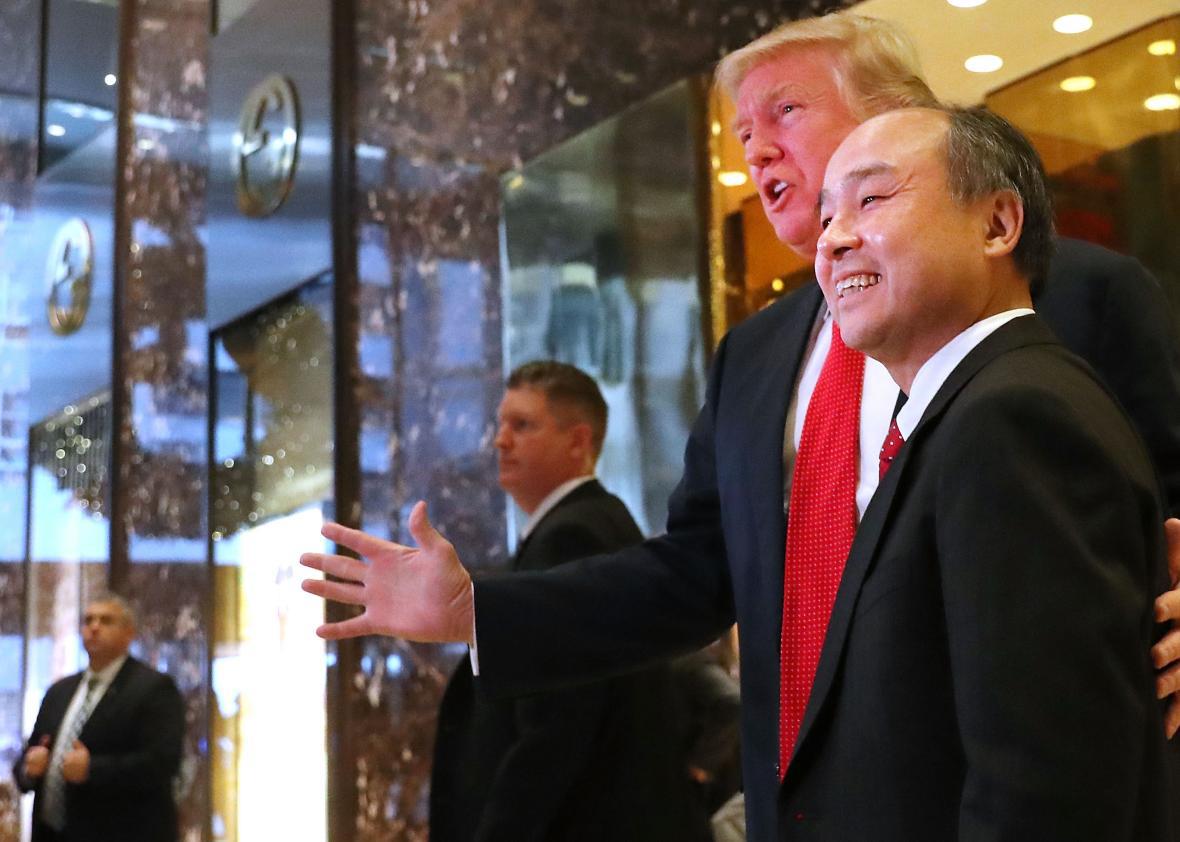In December, Masayoshi Son, the founder of Japanese telecommunications giant SoftBank, met with then-President-elect Donald Trump and pledged to invest $50 billion in the United States and create 50,000 new jobs in the process—an announcement that, on the surface, was of a piece with Trump’s heartland-baiting, job-saving pageantry throughout the presidential transition.
On Tuesday, Son made a start on at least one part of his pledge. He bought … a faded hedge-fund operator?
SoftBank’s plan to buy Fortress Investment Group, a giant, once-mighty, publicly traded firm, for $3.3 billion won’t do anything for factory workers in the Midwest, obviously. Instead, it will provide some balm to the bruised egos of financial operators in midtown Manhattan. It couldn’t be a more perfect symbol of what the Trump era means for doing business.
Almost precisely a decade ago, Fortress Investment Group made a big splash by becoming the first hedge-fund management company to sell shares to the public. Fortress was a darling of the Bush-era credit boom. Thanks to its sharp elbows and smart performance, the firm had amassed $35 billion in assets. The stock offering was priced at $18.50. But such was the enthusiasm among investors—here was a chance to own a piece of a remarkably successful business!—that the stock opened at $35. Fortress’ principals, Wesley Edens and Michael Novogratz, a hard-charging, former helicopter pilot and a Goldman Sachs alum, became billionaires. The entire company was worth about $14 billion.
And then they piloted their high-flying aircraft into a wall.
In theory, hedge funds are supposed to provide noncorrelated performance—when markets crash, they’re supposed to break even, or even gain. Fortress turned out to be a leveraged play on a highly leveraged financial system. The typical way hedge funds get paid—a fixed, 1 percentage fee on the value of assets under management, and performance fees of 20 percent on the gains they manage to produce—magnifies both gains and losses. When the rolling crashes came in 2008, Fortress’ investment returns faltered, driving down the management fees it collected on a proportional basis, and wiping out the performance fees entirely.
As a result, from February 2007 to January 2009 Fortress’ stock lost a stunning 97 percent of its value—hitting a low of about $1.25. In the years since, Fortress has recovered along with the broader markets. But neither the company nor its stock has recovered its swagger. On Tuesday, before the SoftBank deal was announced, the stock was trading at $5.82. In its 10 years as a public company, Fortress’ shares fell about 80 percent, while the S&P 500 has risen more than 60 percent.
During this bull market, the company successfully raised new funds and posted some decent results. But in an age of low volatility and crowded trades, it has been hard for many hedge funds to post returns better than an investor can get by buying an index fund. Fortress looked for new angles by diversifying into private equity, bonds, real estate—all the major food groups. But the mashup has led to poor performance. And when the principals tried to make big bets, they often faltered. Novogratz, who personally oversaw $2 billion in assets, left the firm last year after getting caught on the wrong side of bets on Brazil and the Swiss Franc. As he noted: “But we have had an extremely challenging two years, and I do not believe the current environment is conducive to achieving our best results.”
And while the firm manages some $70 billion in assets, it has been plagued by redemption and stagnant performance. In the 2016 third quarter, Fortress said the assets it managed on which it earned fees were down 6 percent from the year before—this at a time when markets were broadly rallying.
So why is Son interested in Fortress? Well, it does allow him to make a down payment on that commitment to invest $50 billion. But there may be deeper motives at work. Son is in the process of creating a gigantic $100 billion investment fund. SoftBank Vision Fund, backed in large part by Saudi Arabia, will be investing in technology, startups, and big companies. So in addition to gaining $70 billion in assets to manage (a business that should be profitable), Son is acquiring the services of a large number of investment professionals who could theoretically help with the new endeavor. It’s not unlike the acquihires that Silicon Valley companies often do—buying small startups for big prices so they can get access to the engineering talent. Here SoftBank is getting financial engineering talent.
One thing the deal won’t do, however, is create new jobs in the U.S. And in many ways it’s a perfect metaphor for the Trump era, a bold stroke that nevertheless does not deliver on a huge public promise. In an era in which we’re supposed to be focusing on the travails of the working class, the major beneficiaries are a bunch of people who are already insanely rich, and who exploit a loophole in the tax code to avoid paying their fair share of taxes. They’ve been failing the public stockholders who put their faith and money in their hands—and now they’re getting bailed out by a powerful foreigner.
